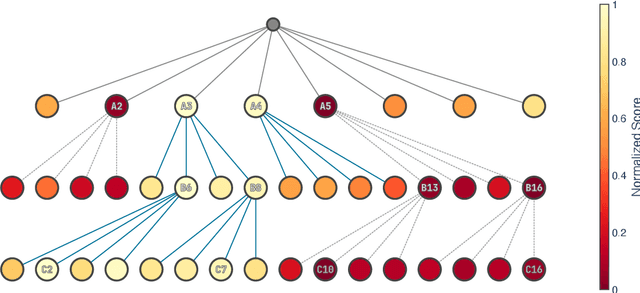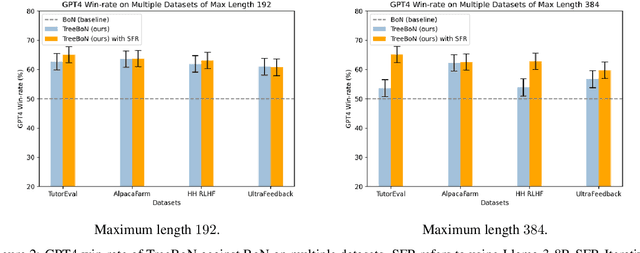Huazheng Wang
Eugene
Provably Efficient Algorithm for Best Scoring Rule Identification in Online Principal-Agent Information Acquisition
May 23, 2025Abstract:We investigate the problem of identifying the optimal scoring rule within the principal-agent framework for online information acquisition problem. We focus on the principal's perspective, seeking to determine the desired scoring rule through interactions with the agent. To address this challenge, we propose two algorithms: OIAFC and OIAFB, tailored for fixed confidence and fixed budget settings, respectively. Our theoretical analysis demonstrates that OIAFC can extract the desired $(\epsilon, \delta)$-scoring rule with a efficient instance-dependent sample complexity or an instance-independent sample complexity. Our analysis also shows that OIAFB matches the instance-independent performance bound of OIAFC, while both algorithms share the same complexity across fixed confidence and fixed budget settings.
Divide, Optimize, Merge: Fine-Grained LLM Agent Optimization at Scale
May 06, 2025Abstract:LLM-based optimization has shown remarkable potential in enhancing agentic systems. However, the conventional approach of prompting LLM optimizer with the whole training trajectories on training dataset in a single pass becomes untenable as datasets grow, leading to context window overflow and degraded pattern recognition. To address these challenges, we propose Fine-Grained Optimization (FGO), a scalable framework that divides large optimization tasks into manageable subsets, performs targeted optimizations, and systematically combines optimized components through progressive merging. Evaluation across ALFWorld, LogisticsQA, and GAIA benchmarks demonstrate that FGO outperforms existing approaches by 1.6-8.6% while reducing average prompt token consumption by 56.3%. Our framework provides a practical solution for scaling up LLM-based optimization of increasingly sophisticated agent systems. Further analysis demonstrates that FGO achieves the most consistent performance gain in all training dataset sizes, showcasing its scalability and efficiency.
Which Agent Causes Task Failures and When? On Automated Failure Attribution of LLM Multi-Agent Systems
Apr 30, 2025Abstract:Failure attribution in LLM multi-agent systems-identifying the agent and step responsible for task failures-provides crucial clues for systems debugging but remains underexplored and labor-intensive. In this paper, we propose and formulate a new research area: automated failure attribution for LLM multi-agent systems. To support this initiative, we introduce the Who&When dataset, comprising extensive failure logs from 127 LLM multi-agent systems with fine-grained annotations linking failures to specific agents and decisive error steps. Using the Who&When, we develop and evaluate three automated failure attribution methods, summarizing their corresponding pros and cons. The best method achieves 53.5% accuracy in identifying failure-responsible agents but only 14.2% in pinpointing failure steps, with some methods performing below random. Even SOTA reasoning models, such as OpenAI o1 and DeepSeek R1, fail to achieve practical usability. These results highlight the task's complexity and the need for further research in this area. Code and dataset are available at https://github.com/mingyin1/Agents_Failure_Attribution
Erasing Without Remembering: Safeguarding Knowledge Forgetting in Large Language Models
Feb 27, 2025



Abstract:In this paper, we explore machine unlearning from a novel dimension, by studying how to safeguard model unlearning in large language models (LLMs). Our goal is to prevent unlearned models from recalling any related memory of the targeted knowledge.We begin by uncovering a surprisingly simple yet overlooked fact: existing methods typically erase only the exact expressions of the targeted knowledge, leaving paraphrased or related information intact. To rigorously measure such oversights, we introduce UGBench, the first benchmark tailored for evaluating the generalisation performance across 13 state-of-the-art methods.UGBench reveals that unlearned models can still recall paraphrased answers and retain target facts in intermediate layers. To address this, we propose PERMU, a perturbation-based method that significantly enhances the generalisation capabilities for safeguarding LLM unlearning.Experiments demonstrate that PERMU delivers up to a 50.13% improvement in unlearning while maintaining a 43.53% boost in robust generalisation. Our code can be found in https://github.com/MaybeLizzy/UGBench.
Memory-Augmented Agent Training for Business Document Understanding
Dec 17, 2024



Abstract:Traditional enterprises face significant challenges in processing business documents, where tasks like extracting transport references from invoices remain largely manual despite their crucial role in logistics operations. While Large Language Models offer potential automation, their direct application to specialized business domains often yields unsatisfactory results. We introduce Matrix (Memory-Augmented agent Training through Reasoning and Iterative eXploration), a novel paradigm that enables LLM agents to progressively build domain expertise through experience-driven memory refinement and iterative learning. To validate this approach, we collaborate with one of the world's largest logistics companies to create a dataset of Universal Business Language format invoice documents, focusing on the task of transport reference extraction. Experiments demonstrate that Matrix outperforms prompting a single LLM by 30.3%, vanilla LLM agent by 35.2%. We further analyze the metrics of the optimized systems and observe that the agent system requires less API calls, fewer costs and can analyze longer documents on average. Our methods establish a new approach to transform general-purpose LLMs into specialized business tools through systematic memory enhancement in document processing tasks.
RA-PbRL: Provably Efficient Risk-Aware Preference-Based Reinforcement Learning
Oct 31, 2024Abstract:Preference-based Reinforcement Learning (PbRL) studies the problem where agents receive only preferences over pairs of trajectories in each episode. Traditional approaches in this field have predominantly focused on the mean reward or utility criterion. However, in PbRL scenarios demanding heightened risk awareness, such as in AI systems, healthcare, and agriculture, risk-aware measures are requisite. Traditional risk-aware objectives and algorithms are not applicable in such one-episode-reward settings. To address this, we explore and prove the applicability of two risk-aware objectives to PbRL: nested and static quantile risk objectives. We also introduce Risk-Aware- PbRL (RA-PbRL), an algorithm designed to optimize both nested and static objectives. Additionally, we provide a theoretical analysis of the regret upper bounds, demonstrating that they are sublinear with respect to the number of episodes, and present empirical results to support our findings. Our code is available in https://github.com/aguilarjose11/PbRLNeurips.
TreeBoN: Enhancing Inference-Time Alignment with Speculative Tree-Search and Best-of-N Sampling
Oct 18, 2024



Abstract:Inference-time alignment enhances the performance of large language models without requiring additional training or fine-tuning but presents challenges due to balancing computational efficiency with high-quality output. Best-of-N (BoN) sampling, as a simple yet powerful approach, generates multiple responses and selects the best one, achieving improved performance but with a high computational cost. We propose TreeBoN, a novel framework that integrates a speculative tree-search strategy into Best-of-N (BoN) Sampling. TreeBoN maintains a set of parent nodes, iteratively branching and pruning low-quality responses, thereby reducing computational overhead while maintaining high output quality. Our approach also leverages token-level rewards from Direct Preference Optimization (DPO) to guide tree expansion and prune low-quality paths. We evaluate TreeBoN using AlpacaFarm, UltraFeedback, GSM8K, HH-RLHF, and TutorEval datasets, demonstrating consistent improvements. Specifically, TreeBoN achieves a 65% win rate at maximum lengths of 192 and 384 tokens, outperforming standard BoN with the same computational cost. Furthermore, TreeBoN achieves around a 60% win rate across longer responses, showcasing its scalability and alignment efficacy.
A Common Pitfall of Margin-based Language Model Alignment: Gradient Entanglement
Oct 17, 2024Abstract:Reinforcement Learning from Human Feedback (RLHF) has become the predominant approach for language model (LM) alignment. At its core, RLHF uses a margin-based loss for preference optimization, specifying ideal LM behavior only by the difference between preferred and dispreferred responses. In this paper, we identify a common pitfall of margin-based methods -- the under-specification of ideal LM behavior on preferred and dispreferred responses individually, which leads to two unintended consequences as the margin increases: (1) The probability of dispreferred (e.g., unsafe) responses may increase, resulting in potential safety alignment failures. (2) The probability of preferred responses may decrease, even when those responses are ideal. We demystify the reasons behind these problematic behaviors: margin-based losses couple the change in the preferred probability to the gradient of the dispreferred one, and vice versa, often preventing the preferred probability from increasing while the dispreferred one decreases, and thus causing a synchronized increase or decrease in both probabilities. We term this effect, inherent in margin-based objectives, gradient entanglement. Formally, we derive conditions for general margin-based alignment objectives under which gradient entanglement becomes concerning: the inner product of the gradients of preferred and dispreferred log-probabilities is large relative to the individual gradient norms. We theoretically investigate why such inner products can be large when aligning language models and empirically validate our findings. Empirical implications of our framework extend to explaining important differences in the training dynamics of various preference optimization algorithms, and suggesting potential algorithm designs to mitigate the under-specification issue of margin-based methods and thereby improving language model alignment.
Conversational Dueling Bandits in Generalized Linear Models
Jul 26, 2024Abstract:Conversational recommendation systems elicit user preferences by interacting with users to obtain their feedback on recommended commodities. Such systems utilize a multi-armed bandit framework to learn user preferences in an online manner and have received great success in recent years. However, existing conversational bandit methods have several limitations. First, they only enable users to provide explicit binary feedback on the recommended items or categories, leading to ambiguity in interpretation. In practice, users are usually faced with more than one choice. Relative feedback, known for its informativeness, has gained increasing popularity in recommendation system design. Moreover, current contextual bandit methods mainly work under linear reward assumptions, ignoring practical non-linear reward structures in generalized linear models. Therefore, in this paper, we introduce relative feedback-based conversations into conversational recommendation systems through the integration of dueling bandits in generalized linear models (GLM) and propose a novel conversational dueling bandit algorithm called ConDuel. Theoretical analyses of regret upper bounds and empirical validations on synthetic and real-world data underscore ConDuel's efficacy. We also demonstrate the potential to extend our algorithm to multinomial logit bandits with theoretical and experimental guarantees, which further proves the applicability of the proposed framework.
Contractual Reinforcement Learning: Pulling Arms with Invisible Hands
Jul 02, 2024Abstract:The agency problem emerges in today's large scale machine learning tasks, where the learners are unable to direct content creation or enforce data collection. In this work, we propose a theoretical framework for aligning economic interests of different stakeholders in the online learning problems through contract design. The problem, termed \emph{contractual reinforcement learning}, naturally arises from the classic model of Markov decision processes, where a learning principal seeks to optimally influence the agent's action policy for their common interests through a set of payment rules contingent on the realization of next state. For the planning problem, we design an efficient dynamic programming algorithm to determine the optimal contracts against the far-sighted agent. For the learning problem, we introduce a generic design of no-regret learning algorithms to untangle the challenges from robust design of contracts to the balance of exploration and exploitation, reducing the complexity analysis to the construction of efficient search algorithms. For several natural classes of problems, we design tailored search algorithms that provably achieve $\tilde{O}(\sqrt{T})$ regret. We also present an algorithm with $\tilde{O}(T^{2/3})$ for the general problem that improves the existing analysis in online contract design with mild technical assumptions.
 Add to Chrome
Add to Chrome Add to Firefox
Add to Firefox Add to Edge
Add to Edge